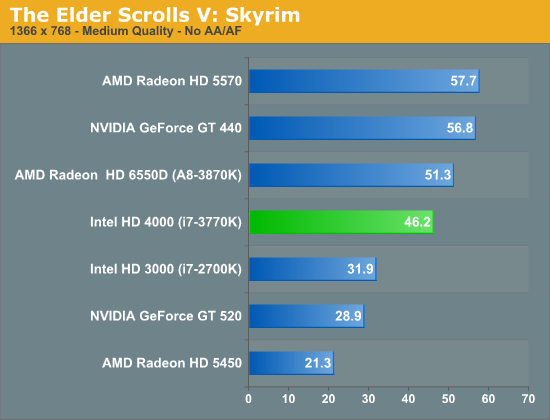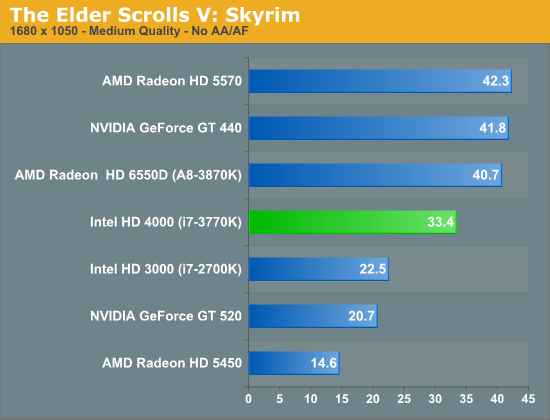The Intel Ivy Bridge (Core i7 3770K) Review
by Anand Lal Shimpi & Ryan Smith on April 23, 2012 12:03 PM EST- Posted in
- CPUs
- Intel
- Ivy Bridge
Bethesda's epic sword & magic game The Elder Scrolls V: Skyrim is our RPG of choice for benchmarking. It's altogether a good CPU benchmark thanks to its complex scripting and AI, but it also can end up pushing a large number of fairly complex models and effects at once. This is a DX9 game so it isn't utilizing any of IVB's new DX11 functionality, but it can still be a demanding game.


Ivy Bridge does very well in Skyrim, not able to reach 60 fps but still above 30 at up to 1680 x 1050. The gains over Sandy Bridge are significant at nearly 50%. Meanwhile Ivy Bridge also gets surprisingly close to Llano, bringing the gap down to 10% at 1366 and 18% at 1680. Seeing as how Skyrim is not particularly shader heavy at these settings, Ivy Bridge looks to be largely shrugging off its biggest bottleneck here in favor of pure pixel pushing power.










173 Comments
View All Comments
aegisofrime - Monday, April 23, 2012 - link
It's interesting to me that this article doesn't include any temperature measurements. I have been hearing that Ivy Bridge has got temperature issues. Could you update the article with those numbers? I'm aware that the article on undervolting and overclocking has some numbers, but none at stock voltage and clocks as far as I know.Stuka87 - Monday, April 23, 2012 - link
I was just going to post the same thing. Where on earth are the temp measurements?Anand Lal Shimpi - Monday, April 23, 2012 - link
Ian's article thoroughly covers the thermal issues, and did include a stock clock graph with voltage scaling:http://images.anandtech.com/doci/5763/Stock%20Spee...
Take care,
Anand
Stuka87 - Tuesday, April 24, 2012 - link
Thanks for responding Anand.The issue I see is in the future, people will look for this review, and not know to look in another article for temp readings.
And I know the other article did have a temp graph, but it did not have the bar graph comparing it to other CPU's like we are used to. I actually have no clue how it compares to a SNB chip after reading this article in terms of temperatures. It would be great to have that information as it aids in building a new system.
Thanks!
samal90 - Monday, April 23, 2012 - link
Okk...so the A8-3870K beats it in almost every gaming benchmark and they are marketing the HD4000....pretty bad for intel. Trinity will completely destroy Ivy bridge then it seems. Every generation, one company is slacking off behind the other...it's always like that. Next year, intel will take the crown..then the year after it will be AMD...and so on.N4g4rok - Monday, April 23, 2012 - link
Not so sure about that actually. I think they're going to fork in two different directions, with Intel being your high compute power desktop friendly option, and AMD being the go to for laptop, notebook, and ultrabook-esque form factors. Unless trinity mucks up big time, AMD will have the IGP thing down. for a while.JarredWalton - Monday, April 23, 2012 - link
I think you're wrong on the "AMD being the go to for laptop..." part. AMD will be the go-to option for people that want an inexpensive laptop with better IGP performance. As I note in the mobile IVB article, mobile Llano GPU performance isn't nearly as impressive relative to IVB as on the desktop. Anyway, AMD will continue to lead on IGP performance with Trinity I'm sure, but there are very large numbers of laptop users that don't even play games. Of course, the highest selling laptops are still going to be the least expensive laptops.DanNeely - Monday, April 23, 2012 - link
For mainstream laptops the real factor is probably going to be battery life. AMD needs to catch up to Intel with power management to get beyond niche products.seasalt - Monday, April 23, 2012 - link
Why is it listed as 77W when the ones already being sold are clearly marked 95W on the boxes?http://www.nordichardware.com/news/69-cpu-chipset/...
mechwarrior1989 - Monday, April 23, 2012 - link
It's in the article..."Note that max TDP for Ivy Bridge on the desktop has been reduced from 95W down to 77W thanks to Intel's 22nm process. The power savings do roughly follow that 18W decrease in TDP. Despite the power reduction, you may see 95W labels on boxes and OEMs are still asked to design for 95W as Ivy Bridge platforms can accept both 77W IVB and 95W Sandy Bridge parts."